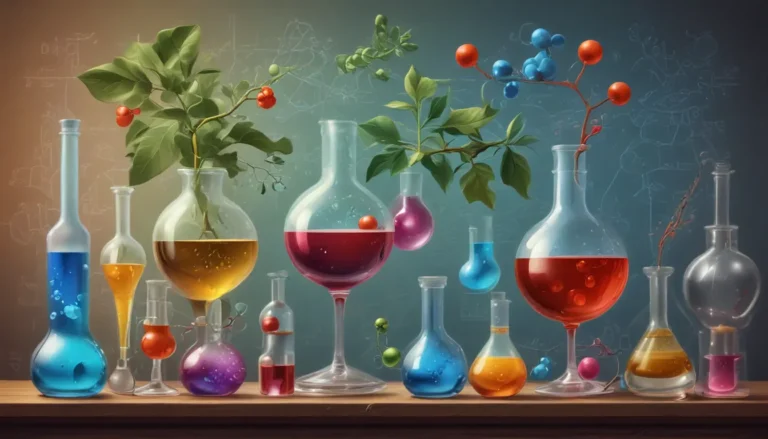A Note About Images: The images used in our articles are for illustration purposes only and may not exactly match the content. They are meant to engage readers, but the text should be relied upon for accurate information.
Hydrolysis, a fundamental chemical process that occurs in various contexts, from the human body to industrial applications, is a true marvel of science. In this article, we will embark on a fascinating journey into the realm of hydrolysis and unveil 15 unbelievable facts about this awe-inspiring chemical reaction. From its pivotal role in digestion to its impact on drug stability, the discoveries surrounding hydrolysis are sure to captivate and inspire you. So, buckle up and prepare to be amazed by the incredible world of hydrolysis!
Hydrolysis: Unraveling the Mysteries
Hydrolysis is a super important chemical process that helps break down food, make soap, and even create paper. It’s like a superhero for the environment and our bodies! Enzymes are like the sidekicks that help hydrolysis work faster and better. They make everything from making medicine to cleaning stains possible.
The Role of Hydrolysis in Digestion
The human body relies on hydrolysis to break down complex carbohydrates, proteins, and fats into simpler molecules that can be easily absorbed and utilized. This essential process ensures that our bodies can extract the necessary nutrients from the food we consume.
Hydrolysis: The Synthesis of DNA and RNA
During DNA and RNA synthesis, hydrolysis reactions are utilized to link nucleotides together, forming the backbone of these essential genetic materials. This intricate process highlights the crucial role of hydrolysis in the synthesis of genetic information.
The Magic of Hydrolysis in Polymers
Polymers, such as plastics, can undergo hydrolysis when exposed to water and heat, leading to their degradation and breakdown into smaller, more manageable fragments. This phenomenon showcases the transformative power of hydrolysis in altering the chemical structure of polymers.
From Vegetable Oils to Biodiesel: The Hydrolysis Connection
Triglycerides, found in vegetable oils and animal fats, can be converted into biodiesel through hydrolysis, offering a sustainable alternative to traditional fossil fuels. This process exemplifies the versatility of hydrolysis in the production of renewable energy sources.
The Alchemy of Soap: Hydrolysis at Play
The saponification process involves the hydrolysis of fats or oils with an alkali, resulting in the production of soap and glycerol. This time-honored technique highlights the pivotal role of hydrolysis in the creation of essential household products.
Hydrolysis: Nurturing the Water Cycle
Hydrolysis reactions are integral to the natural water cycle, breaking down water molecules to release essential nutrients for plants and ecosystems. This process underscores the interconnectedness of hydrolysis with environmental processes.
A Cellular Cleaning Crew: Hydrolysis in Waste Degradation
Within cells, hydrolysis reactions play a vital role in breaking down unnecessary or damaged molecules, enabling their proper disposal and recycling. This cellular clean-up process demonstrates the indispensable nature of hydrolysis in maintaining cellular health.
The Enzymatic Boost: Catalyzing Hydrolysis
Enzymes act as catalysts for hydrolysis reactions, lowering the activation energy required for the process to occur efficiently. Their involvement enhances the speed and effectiveness of hydrolysis, showcasing the vital partnership between enzymes and hydrolysis.
Turning Wood into Paper: The Craft of Hydrolysis
The hydrolysis of cellulose fibers in wood helps break them down into individual cellulose molecules, which are then used to create paper products. This application highlights the transformative power of hydrolysis in the paper-making industry.
Brewing Magic: Hydrolysis in Fermentation
The breakdown of complex sugars into simpler compounds through hydrolysis is essential in the production of alcoholic beverages like beer and wine. This process underscores the crucial role of hydrolysis in the production of beloved beverages.
Lactose Digestion Made Easy: The Role of Hydrolysis
Lactose hydrolysis is essential for individuals who are lactose intolerant, enabling them to break down lactose into its more easily digestible components. This process allows individuals to enjoy dairy products without discomfort.
Banishing Stains: Hydrolysis in Laundry
In laundry detergents, hydrolysis assists in breaking down tough stains by breaking their chemical bonds, making them easier to remove during washing. This feature showcases the stain-fighting power of hydrolysis in everyday cleaning.
Sculpting Landscapes: Hydrolysis and Rock Weathering
Hydrolysis reactions contribute to the gradual breakdown and erosion of rocks over time, shaping the Earth’s surface and creating new landscapes. This natural process demonstrates the transformative impact of hydrolysis on geological formations.
The Pillars of Pharmaceuticals: Hydrolysis in Drug Production
Pharmaceutical chemists utilize hydrolysis reactions to synthesize and modify compounds crucial for the development of medications and treatments. The role of hydrolysis in pharmaceutical production highlights its significance in the healthcare industry.
Fueling the Body: Hydrolysis in Carbohydrate Metabolism
Hydrolysis breaks down complex carbohydrates, such as starch and glycogen, into their monosaccharide components, providing a vital source of energy for the body. This metabolic process underscores the essential role of hydrolysis in nutrient absorption.
These 15 remarkable facts shed light on the profound impact of hydrolysis across various domains of science and industry. From its intricate involvement in biological processes to its pivotal role in industrial applications, hydrolysis continues to shape our world in remarkable ways.
Unveiling the Marvels of Hydrolysis
Hydrolysis is a captivating chemical process that leaves a lasting imprint on both biological and industrial landscapes. Through the exploration of these 15 unbelievable facts about hydrolysis, we gain a deeper appreciation for the complexities and wonders of this essential reaction.
Whether you are a chemistry enthusiast, a student eager to learn, or a curious mind intrigued by the mysteries of science, the realm of hydrolysis offers a wealth of knowledge and inspiration. Embrace the thrill of discovery as you unravel the secrets of hydrolysis and witness its transformative power in action.
FAQs: Quenching Your Curiosity
-
What is hydrolysis?
Hydrolysis is a chemical reaction where water molecules break down larger molecules into smaller compounds by disrupting the chemical bonds holding them together. -
What are some examples of hydrolysis reactions?
Examples of hydrolysis reactions include the breakdown of starch into glucose, the decomposition of proteins into amino acids, and the hydrolysis of fats into glycerol and fatty acids. -
How does hydrolysis occur in the human body?
Hydrolysis is crucial in digestion, as it facilitates the breakdown of complex molecules in food into simpler forms that can be absorbed and utilized by the body. -
What are the industrial applications of hydrolysis?
Hydrolysis finds widespread use in industries such as biofuel production, pharmaceutical manufacturing, and the synthesis of detergents and cleaning agents. -
How does hydrolysis contribute to the water cycle?
Hydrolysis plays a vital role in the water cycle by breaking down water molecules, releasing essential nutrients for plants and ecosystems to thrive. -
Can hydrolysis reactions be reversed?
In certain instances, hydrolysis reactions can be reversed through a process known as condensation or dehydration synthesis, where smaller molecules combine to form larger ones. -
Are there any risks associated with hydrolysis reactions?
While hydrolysis is a natural process, some reactions can be hazardous if not conducted carefully. Certain substances may emit toxic or flammable gases during hydrolysis. -
How is hydrolysis influenced by pH?
The rate of hydrolysis reactions can be affected by the acidity (pH) of the solution. Higher pH levels generally accelerate the rate of hydrolysis. -
Are enzymes involved in hydrolysis?
Yes, enzymes called hydrolases play a key role in catalyzing hydrolysis reactions, speeding up the breakdown of specific molecules. -
Can hydrolysis occur in non-aqueous solutions?
While hydrolysis is commonly associated with water, it can also take place in non-aqueous solvents such as sulfuric acid or supercritical carbon dioxide.
Hydrolysis stands as a testament to the wonders of chemical reactions, offering a gateway to understanding the intricate workings of the natural world. As you delve into the captivating realm of hydrolysis, you embark on a journey of exploration and enlightenment. Embrace the mysteries of science as you unveil the transformative power of hydrolysis in shaping our world.






